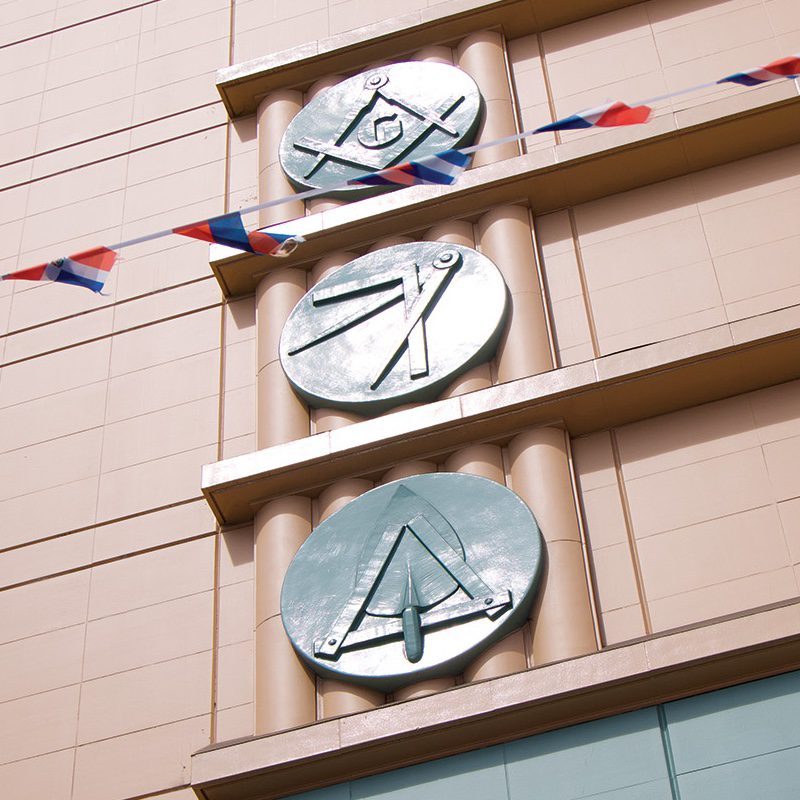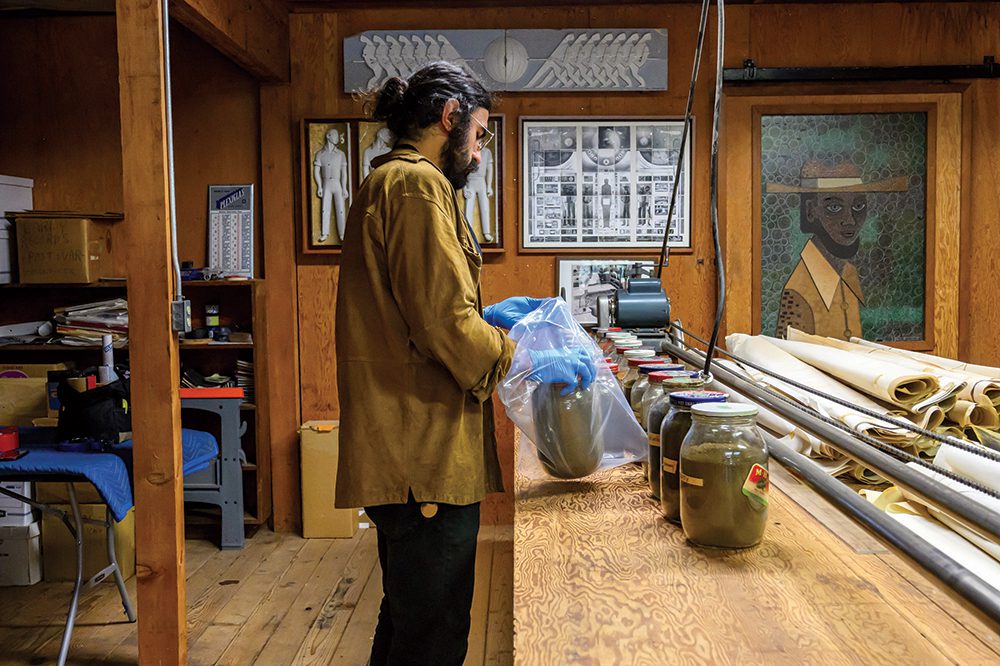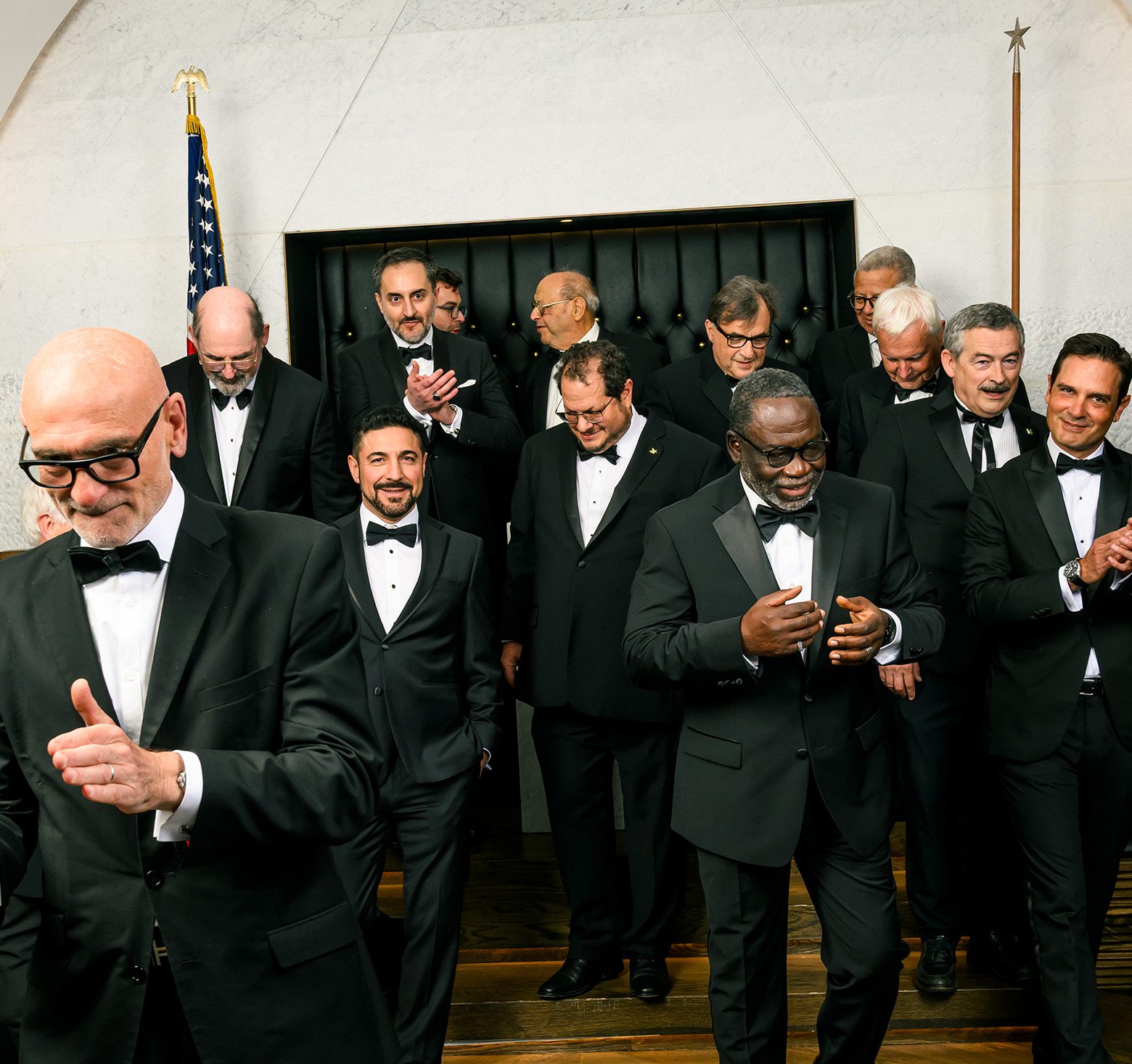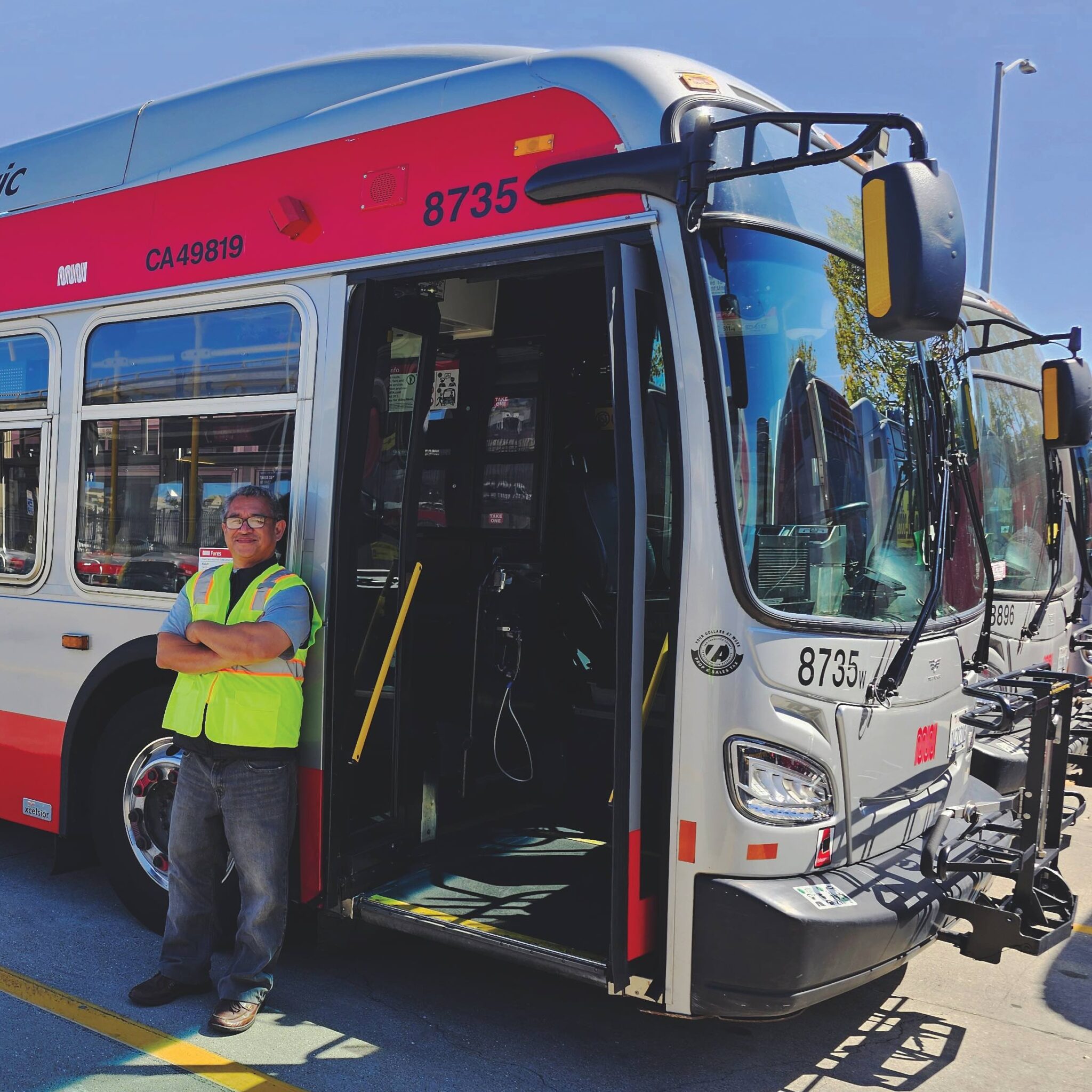
The Mission Masonic Temple, a Splendid Survivor
Hiding in plain sight on one of the city’s busiest blocks, the Mission Masonic Temple is a living link to the area’s wild and wooly past.
Above: Movers load up artworks from Emile Norman’s Big Sur Home and Studio for delivery to San Francisco, where they will be housed at the Henry Wilson Coil Library and Museum of Freemasonry.
Before anyone has even entered the California Masonic Memorial Temple, they’ve experienced the artwork of Emile Norman. First, visible from blocks away, they’re greeted by a dramatic bas-relief frieze on the California Street façade: four sturdy men, representing the branches of the armed forces, beside a struggle between good and evil. Then, even more dramatically, as they enter the building’s foyer: Norman’s stunning 48-by-38-foot endomosaic window, a glowing rendering of Masonic history and symbolism.
That makes the temple a living testament, if also an unlikely one, to Norman’s singular artistic career. This summer, that connection was heightened as a collection of the late artist’s archives, sketches, maquettes, and other material was delivered to the temple, where it will be housed within the Henry W. Coil Library and Museum of Freemasonry. Norman’s collection will join Masonic aprons, medallions, and records—what archivist and collection manager Joe Evans describes as the “material culture of Masonry.”
It’s the first artist’s archive to join the museum’s collection. But given Norman’s close ties to the temple, it’s an addition that makes sense. “It feels appropriate to us, because Emile and the Masons of California, their relationship goes so far back and was so mutually endearing and supportive,” says Heather Engen, executive director of the Emile Norman Arts Foundation. “So we feel really good about this being a first step in the process of sharing Emile’s legacy.”

The story of how Norman, who died in 2009, received the commission from the Masons to execute his endomosaic is a fantastic part of that legacy. Norman had no special connection to Freemasonry. He was a gay man in his late 30s, living with his partner, Brooks Clement, in their custom-built home on Big Sur’s remote and scenic Pfeiffer Ridge, overlooking the Pacific Ocean.
His first endomosaic—an artistic approach of his own invention, which involved sandwiching glass, seashells, foliage, and other materials between layers of acrylic—was spotted by the modernist architect Albert F. Roller at a hotel in Monterey. Roller, a member of Excelsior № 166, had been hired in 1952 to design the headquarters for the state fraternity. Impressed by the artworks, he commissioned Norman to develop a pair of monumental pieces for the new temple.
The frieze and endomosaic are Norman’s crowning achievements and his most visible contributions to art history. They were also a massive undertaking. To create the 45 panels of the endomosaic, each weighing 250 pounds, Norman had to add an entire lower-level studio to his home. “It literally formed the shape of his house,” Engen says.
Over the past two years, as archivist Jason Christian and the Emile Norman Arts Foundation have catalogued the home’s contents, they kept discovering items connected to the temple, Engen says. Among them: a letter from Norman to an Italian stonemason, trying to locate the blocks of marble that would become part of the frieze; photos of Norman and Brooks in a marble quarry; curious stereoscopic images of the building’s exterior; and 25 leftover jars of soil that went into the endomosaic, including samples from each of California’s 58 counties and the Hawaiian Islands.
All these items, along with boxes of correspondence, newspaper clippings, scale models of the temple, sketches of the endomosaic, and a broken panel that shows how Norman assembled its layers, will go into the temple museum’s collection.
Norman and Clement’s Big Sur home, itself a work of art, still contains decades of the artist’s work and thousands of items. Even after moving so much material to San Francisco, fragments from his commission will still remain in the house. Its kitchen, for instance, is covered with the same gold tiles that form the background of the temple’s frieze.
Above: A maquette for the bas relief on the façade of the California Masonic Memorial Temple. Norman used several of his neighbors as models.
Norman’s collection is significant not just because of its relationship to the temple’s construction. The material also tells a story about mid-century artmaking and California art history that hasn’t been fully told before. Once the collection is entered into the museum’s catalog records, Evans will upload them to the Online Archive of California, where researchers can learn, for the first time, that these materials exist.
Currently, Evans says, many of the researchers contacting him are genealogists interested in family records. Others are historians or anthropologists looking at Freemasonry and fraternalism in American society. “I actually learn more about the collection by people asking me questions about it,” Evans says. “I’m like, ‘Oh, here’s this. I didn’t know we had this kind of thing.’”
Evans points out that moving the Norman collection to the temple will help ensure its survival. The Big Sur home is 15 minutes up a winding road off Highway 1 in an area prone to extreme temperature shifts, wildfires, and mudslides. Given these environmental conditions, Engen says, “We’re so fortunate that this is here. Shifting part of the collection to the temple aligns with the Emile Norman Arts Foundation’s efforts to preserve and share Norman’s legacy.”
Eventually, Engen says, the goal is to create a permanent public display of Norman’s Masonic-related archives at the temple. There might even be room in the future to show some of Norman’s other art on a rotating basis. “Emile’s story is one that really embodies West Coast idealism,” Engen says. “It’s the dream of California, of reinventing oneself to live a life of freedom and creativity while finding kinship and community.” That isn’t so far off from the Masonic narrative depicted in the endomosaic, she suggests—a scene of brotherhood rooted in the state’s soil.
Norman’s collection is significant not just because of its relationship to the temple’s construction. The material also tells a story about mid-century artmaking and California art history that hasn’t been fully told before. Once the collection is entered into the museum’s catalog records, Evans will upload them to the Online Archive of California, where researchers can learn, for the first time, that these materials exist.
Currently, Evans says, many of the researchers contacting him are genealogists interested in family records. Others are historians or anthropologists looking at Freemasonry and fraternalism in American society. “I actually learn more about the collection by people asking me questions about it,” Evans says. “I’m like, ‘Oh, here’s this. I didn’t know we had this kind of thing.’”
Evans points out that moving the Norman collection to the temple will help ensure its survival. The Big Sur home is 15 minutes up a winding road off Highway 1 in an area prone to extreme temperature shifts, wildfires, and mudslides. Given these environmental conditions, Engen says, “We’re so fortunate that this is here. Shifting part of the collection to the temple aligns with the Emile Norman Arts Foundation’s efforts to preserve and share Norman’s legacy.”
Eventually, Engen says, the goal is to create a permanent public display of Norman’s Masonic-related archives at the temple. There might even be room in the future to show some of Norman’s other art on a rotating basis. “Emile’s story is one that really embodies West Coast idealism,” Engen says. “It’s the dream of California, of reinventing oneself to live a life of freedom and creativity while finding kinship and community.” That isn’t so far off from the Masonic narrative depicted in the endomosaic, she suggests—a scene of brotherhood rooted in the state’s soil.
Photographs by: Winni Wintermeyer

Hiding in plain sight on one of the city’s busiest blocks, the Mission Masonic Temple is a living link to the area’s wild and wooly past.

At the French-speaking La Parfaite Union No. 17 Masonic lodge, in San Francisco, a Francophone legacy lives on.

At San Francisco No. 120, a crew of streetcar workers are making theirs the “Muni Lodge.”